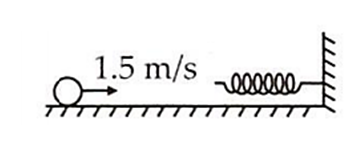 Multiple Choice Questions
Multiple Choice QuestionsA body of mass 5 kg moving with a speed of 1.5 m/s on a horizontal smooth surface collides with a nearly weightless spring of force constant k = 5 N/m. The maximum compression of the spring would be

0.5 m
0.15 m
1.5 m
0.12 m
C.
1.5 m
At maximum compression the whole kinetic energy of ball = potential energy of spring
⇒ x = v
⇒ x = 1.5 ×
⇒ x = 1.5 m
Neglecting the density of air, the thermal velocity obtained by a raindrop of radius 0.3 nm falling through air of viscosity 1.8 × 105 N s m2 will be
10.9 m s-1
7.48 m s-1
3.7 m s-1
12.8 m s-1
A particle executes simple harmonic motion of period T and amplitude l along a rod AB of length 2l. The rod AB itself executes simple harmonic motion of the same period and amplitude in a direction perpendicular to its length. Initially, both the particle and the rod are in their mean positions. The path traced out by the particle will be

a circle of radius l
a straight line inclined at to the rod
an ellipse
a figure of eight
When a current is passed in a conductor, 3o C rise in temperature is observed. If the strength of current is made thrice, then rise in temperature will approximately be
36oC
27o C
18o C
9o C
In a metal with positive Thomson coefficient, current is passed from the lower temperature to higher temperature to higher temperature side. The heat will be
absorbed
constant
evolved
either 'b' or 'c'
A ball is suspended by a thread of length L at the point O on a wall which is inclined to the vertical . The thread with the ball is displaced by a small angle β away from the wall. If the ball is released, the period of oscillation of the pendulum when β > will be
Assertion: Liquid molecules have greater potential energy at the melting point.
Reason: Intermolecular spacing between molecules increases at melting point.
If both assertion and reason are true and reason is the correct explanation of assertion.
If both assertion and reason are true but reason is not the correct explanation of assertion.
If assertion is true but reason is false.
If both assertion and reason are false.
Assertion: The bob of a simple pendulum is a ball full of water, if a fine hole is made in the bottom of the ball, the time period first increases and then decreases.
Reason: As water flows out of the bob the weight of bob decreases.
If both assertion and reason are true and reason is the correct explanation of assertion.
If both assertion and reason are true but reason is not the correct explanation of assertion.
If assertion is true but reason is false.
If both assertion and reason are false.
Assertion: For an isothermal process in an ideal gas, the heat obsorbed by the gas is entirely used in the work done by the gas.
Reason: During a process taking place in a system, the temperature remains constant then the process is isothermal.
If both assertion and reason are true and reason is the correct explanation of assertion
If both assertion and reason are true but reason is not the correct explanation of assertion
If assertion is true but reason is false
If both assertion and reason are false
Assertion: When hot water is poured in a beaker of thick glass, the beaker cracks.
Reason: Outer surface of the beaker expands suddenly.
If both assertion and reason are true and reason is the correct explanation of assertion
If both assertion and reason are true but reason is not the correct explanation of assertion
If assertion is true but reason is false
If both assertion and reason are false
